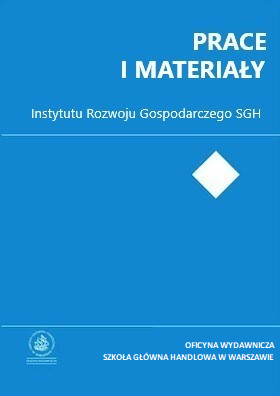Aktywność kredytowa banków w cyklu koniunkturalnym
##plugins.themes.bootstrap3.article.main##
Abstrakt
W artykule potraktowano sektor finansowy jako istotny czynnik napędowy fluktuacji koniunkturalnych. Powszechnie przyjęte wyjaśnienie procykliczności systemu finansowego wyrasta z asymetrii informacji między pożyczkobiorcami i pożyczkodawcami. Minsky zaproponował teorię wiążącą kruchość rynku finansowego w toku normalnego funkcjonowania gospodarki z narastaniem baniek spekulacyjnych endogenicznych w stosunku do rynków finansowych. Jednym z wyjaśnień cykli ekonomicznych i finansowych jest także akcelerator finansowy. Stwarza on teoretyczne ramy, w których bilans pożyczkobiorców i wartość oferowanego przez nich zastawu są źródłami fluktuacji w sferze realnej. Dodatkowym materialnym źródłem procykliczności sektora finansowego jest nieadekwatna reakcja uczestników rynku finansowego na zmiany ryzyka w czasie. Zachowanie instytucji finansowych w cyklu koniunkturalnym zależy od postrzegania przez nie ryzyka. W ożywieniu nadmierny optymizm banków odnośnie do perspektyw dłużników, w połączeniu z poprawą bilansów banków w warunkach zaostrzającej się konkurencji, prowadzą do liberalnej polityki kredytowej, powodującej obniżenie standardów kredytowych. (abstrakt oryginalny)
##plugins.themes.bootstrap3.article.details##
Bibliografia
Adrian T., Shin H. S., Liquidity, monetary policy and financial cycles, „Federal Reserve Bank of New York Current Issues in Economics and Finance”, nr 1, 2008
Aghion P., Bacchetta P., Banerjee S., Capital market instability of open economies, Swiss National Bank Working Papers, nr 1, 1999
Aghion P., Angeletos G. M., Banerjee A., Manova K., Volatility and growth: Credit constraints and productivity-enhancing investment, NBER Working Paper, nr 11349, 2005
Berger A. N., Udell G. F., The institutional memory hypothesis and the procyclicality of bank lending behaviour, BIS Working Papers, nr 125, 2003
Bernanke B., Gertler M., Agency costs, collateral, and business fluctuations, NBER Working Paper, nr 2015, 1986
Bernanke B., Gertler M., Gilchrist S., The financial accelerator in a quantitive business cycle framework, NBER Working Paper, nr 6455, 1998
Borio S., Furfine C., Lowe P., Procyclicality of the financial system and financial stability: Issues and policy options, BIS Papers, nr 1, 2001
Cetorelli N., Goldberg L. S., Banking globalization, monetary transmission, and the lending channel, NBER Working Paper, nr 14101, 2008
Chen Y., Banking panics: The role of the first-come, first-served rule and information externalities, „Journal of Political Economy”, nr 5, 1999
Clair R. T., Loan growth and loan quality: Some preliminary evidence from Texas banks, „Economic and Financial Policy Review Federal Reserve Bank of Dallas”, nr 3, 1992
Favara G., Agency problems and endogenous economic fluctuations, National Centre of Competence in Research Financial Valuation and Risk Management Working Paper, nr 395, 2006
Financial sector procyclitality. Lessons from the crises, Banco d’Italia Occasional Paper, nr 44, 2009
Fry M. J., In favour of financial liberalization, „The Economic Journal”, 1997 (maj)
Gennaioli N., Shleifer A., Vishny R. W., Neglected risks, financial innovation, and financial fragility, NBER Working Paper Series, nr 16068, 2010
Hellmann T. F., Murdock K. C., Stiglitz J. E., Liberalization, moral hazard in banking, and prudential regulation. Are capital requirements enough?, „American Economic Review”, nr 1, 2000
Jensen M. C., Meckling W. H., Theory of the firm managerial behaviour, agency costs, and ownership structure, „Journal of Financial Economics”, nr 4, 1976
Jimenez G., Saurina J., Credit cycles, credit risk, and prudential regulation „International Journal of Central Banking”, 2006 (czerwiec)
Kaufman G. G., Bank contagion: A review of the theory and evidence, „Journal of Financial Services Research”, nr 2, 1994 Kiyotaki N., Moore J., Credit cycles, „Journal of Political Economy”, nr 2, 1997
Lorenzoni G., Inefficient credit booms, „Review of Economic Studies”, nr 3, 2008
Lowe P., Rohling T., Agency costs, balance sheet and the business cycle, Economic Research Department Reserve Bank of Australia Research Discussion Paper, nr 9311, 1993
Lown C. S., Morgan D. P., The credit cycle and the business cycle: New findings using the senior loan officer survey., „Journal of Money, Credit, and Banking”, nr 6, 2002
Markovic B., Bank capital channels in the monetary transmission mechanism, Bank of England Working Paper, nr 313, 2006
Meh C., Moran K., The role of bank capital in the propagation of shocks, Bank of Canada Working Paper, nr 36, 2008
Minsky H. P., The financial instability hypothesis, The Levy Economics Institute of Bard College Working Paper, nr 74, 1992
Minsky H. P., Stabilizing an unstable economy, Yale University Press, New Heaven 1986
Mitchell W. S., What happens during business cycles, National Bureau of Economic Research, Nowy Jork 1951
Rajan R. G.., Why bank credit policies fluctuate: A theory and some evidence, „Quarterly Journal of Economics”, nr 2, 1994
Shleifer A., Vishny R. W., Liquidation values and debt capacity: A market equilibrium approach, „Journal of Finance”, nr 4, 1992
Sunirand P., The role of bank capital and the transmission mechanism of monetary policy, FMG Discussion Papers, nr 433, 2002
Towsend R., Optimal contracts and competitive markets with costly state verification, „Journal of Economic Theory”, 1979 (październik)
Thurow L., Fortuna sprzyja odważnym, Warszawskie Wydawnictwo Literackie Muza S. A., Warszawa 2007
Ugo A., Gambacorta L., Bank profitability and the business cycle, „Temi di Discussione del Servizio Studi Banca d’Italia”, nr 601, 2006
Zhang H., Financial sector shocks, external finance premium and business cycle, Cardiff Economics Working Papers, nr E2011/7, 2011
